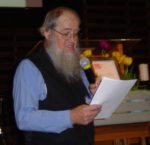by
Larry Pearce
4/24/17 rev. 5/8/17
Members of the Swiss Anabaptist Genealogical Association came from eight states to the Oak Dale Mennonite Church in Salisbury, Somerset County, PA, April 21 & 22, 2017, for their annual meeting. The event began Friday afternoon with a bus tour of the area, which had nurtured many anabaptist families as they made their way west, including Yoder, Hochstetler, Miller, Saylor, Bontdrager, Bender, Beachy, Mast, and others. Guides and speakers for the meeting were local historians James L. Yoder and “Greenhouse” Benny C. Yoder. Stops on the bus tour included the Niverton Amish church, established in 1881, and the Mt. Davis lookout, the highest point in Pennsylvania. Riders were given some of the rich historical background of this lush land that has made it so important in American history:
1750-The first White frontiersman to explore here was surveyor Christopher Gist with Indian guide Nemacolin;
1754-George Washington made the first trip through here prior to the French & Indian War of what would be a total of seven in his lifetime;
1813-Construction of the beautiful 354-foot Stone Bridge over the Casselman River, an architectural wonder;
1818-Dedication of the National Road from Cumberland to Pittsburgh, essentially opening up travel through the northern Allegheny Mountains to the West.
SAGA began in 1995 as a way to bring together genealogists working on Anabaptist families throughout the world. Having no office nor paid staff, the 400-plus member organization offers its website ( http://www.saga-omii.org ) to access family databases containing literally millions of names, dates, and records. The site also offers links to free public online sources.
After a Saturday morning welcome by event organizer and Recording Secretary Rev. Loren Johns and short business meeting conducted by Chair Troye Kauffman, the informational portion of the gathering began, entitled “The Significance of the Casselman Valley for Family History and for Migrations Further West.”
Benny Yoder referred to Somerset County as “the gateway to the West” for Anabaptists, and comically compared Somersetʼs “one field to seven hills” to Holmes County, Ohioʼs “seven fields to one hill,” more suitable for farming. But to the families that remained, the fertile land between the Negro and Meadow Mountains must have reminded them of their Swiss homeland, and they continued to share agricultural abundance with the “mixed religious denominations and cultures” who settled among them. Benny Yoder concluded by saying that in many ways not much has changed here since the Anabaptists settled in Somerset County in the 1700ʼs. Yes, today some farming techniques have improved, and some small shops have sprung up, providing work for the younger generations who stayed, but religious denominations and ancestry is only an identity – where we came from, not where we are going. Our “salvation” is our faith and our hope.
Jim Yoder provided a brief 100-year history of the transition of Anabaptists through Somerset Count beginning with John Yoder in 1770. In all, about 60 families and individuals came from eastern Pennsylvania and Carroll County, MD, from 1770 to 1800 after the Ft. Stanwix treaty with Native Americans. Over 10,000 acres were purchased, deeded, and settled by the Anabaptists before 1800, with more afterward. Eventually, four Amish churches were built, with three still in use. Other Amish communities flourished and faded to the north and the south, but mostly their strong Christian foundation remains. Those who moved on went to other parts of Pennsylvania, while others, saying what must have been a tearful goodbye, headed for distant Ohio, Kentucky, and beyond. By 1891, over 130 families had emigrated from the Casselman River Valley. The reasons for the emigration to and through Somerset County were many but might be summarized as follows: freedom to practice their faith and opportunities to acquire land to support growing families.
As always, good food and fellowship accompanied this yearʼs meeting. Opportunities to have research questions answered by others and to purchase valuable source texts from vendors is a staple of these assemblies. Next yearʼs SAGA gathering is tentatively set to be held in Michigan.




My wife and I attended a spring flower auction on May 2, 2017, conducted by the Amish of Stringtown, near Iowa City, IA. Along with good fellowship and food, the participants enjoyed the chance to support the local community while benefitting from the generous wholesale prices. Lots of “Dutch” dialect was spoken, and best of all, some of the growers and buyers to whom we talked knew and had good things to say about “Greenhouse” Benny C. Yoder of Somerset County, PA. The participant families (spellings vary) included: Beachy, Bender, Brennemen, Bondtrager, Hosteddler, Miller, Yoder, and others. What a wonderful small world!
Larry Pearce